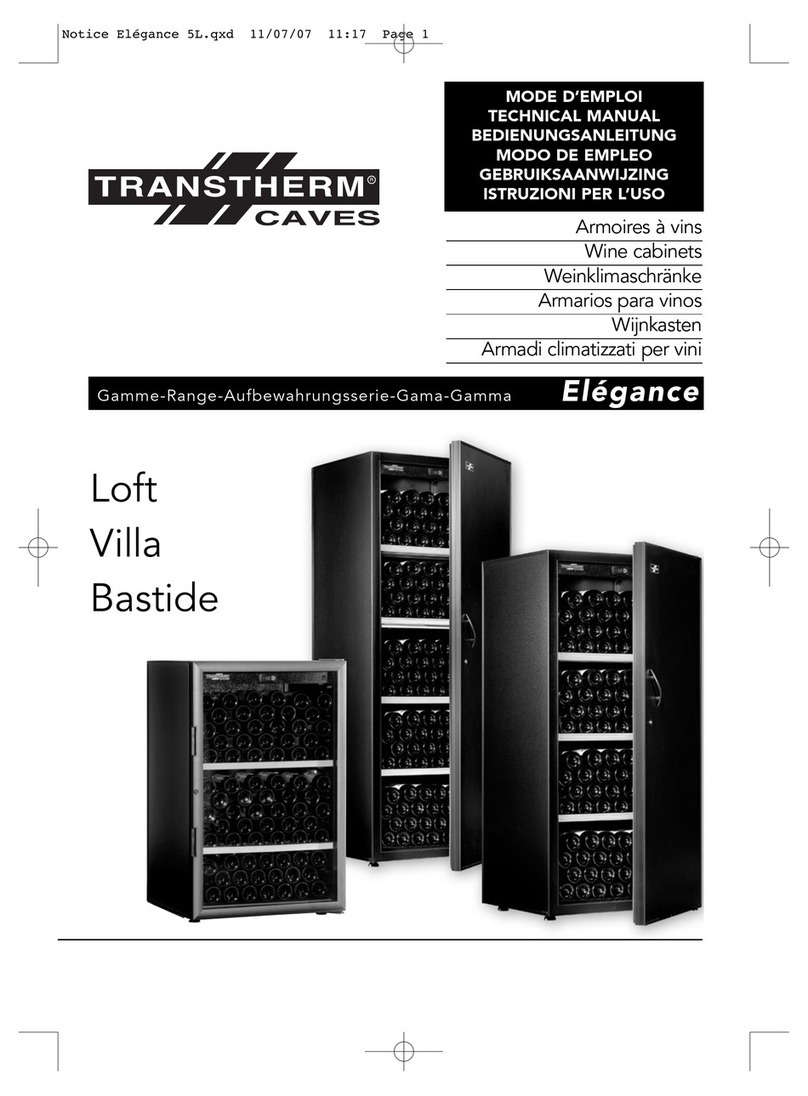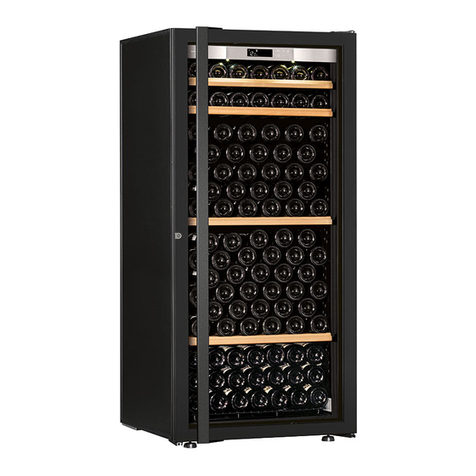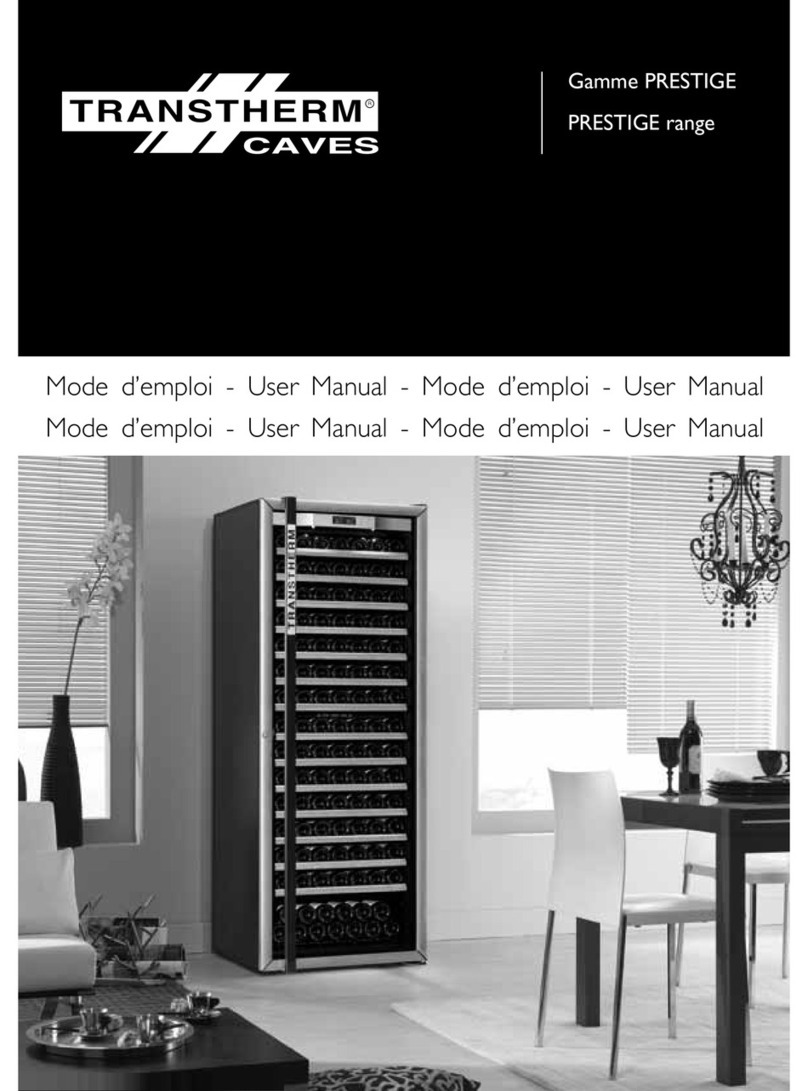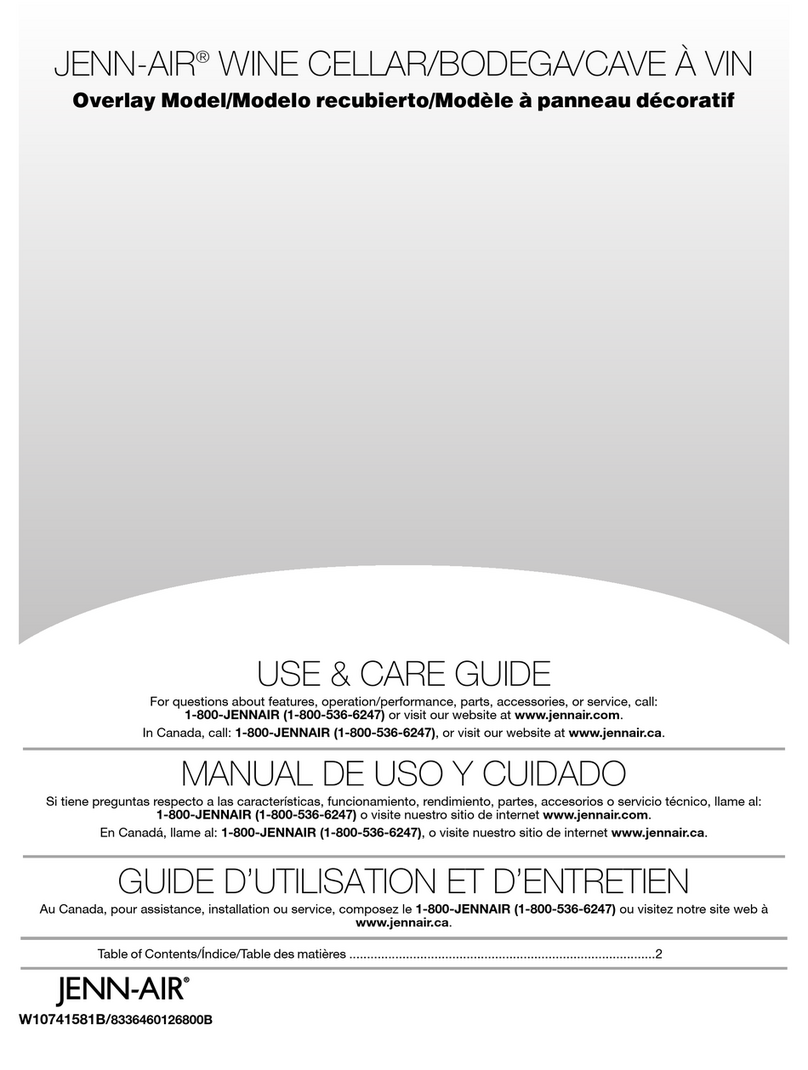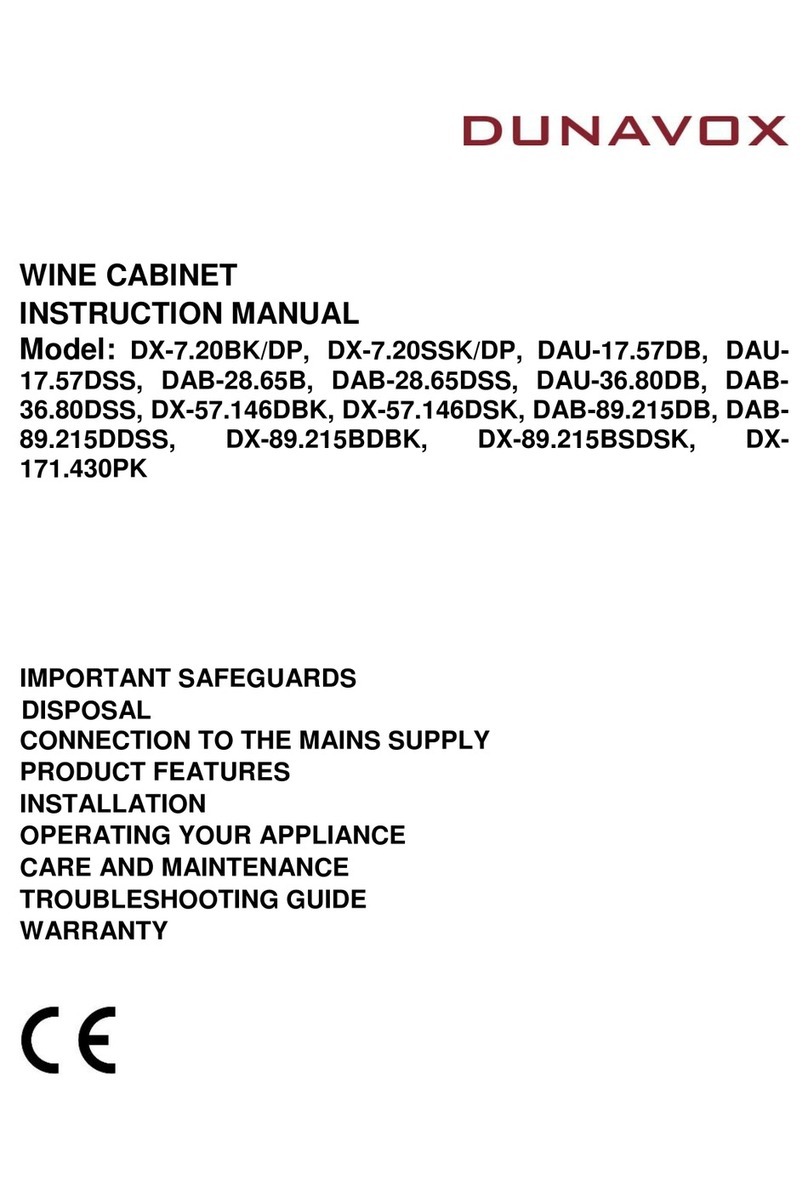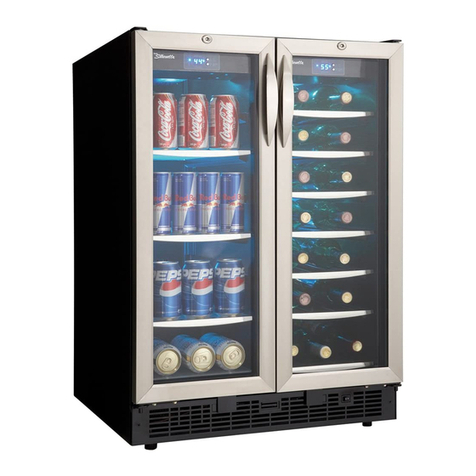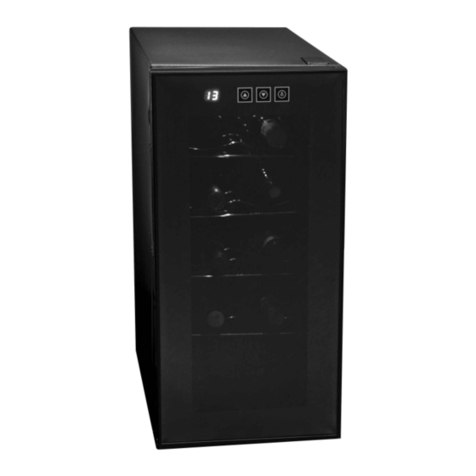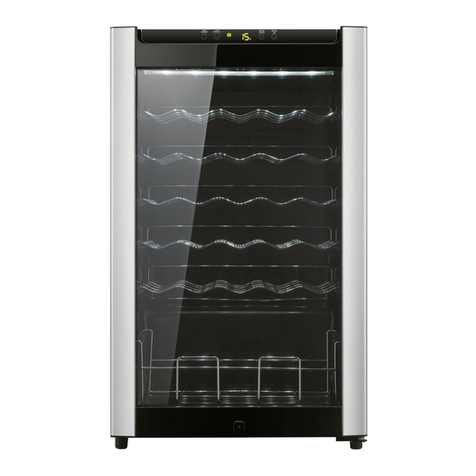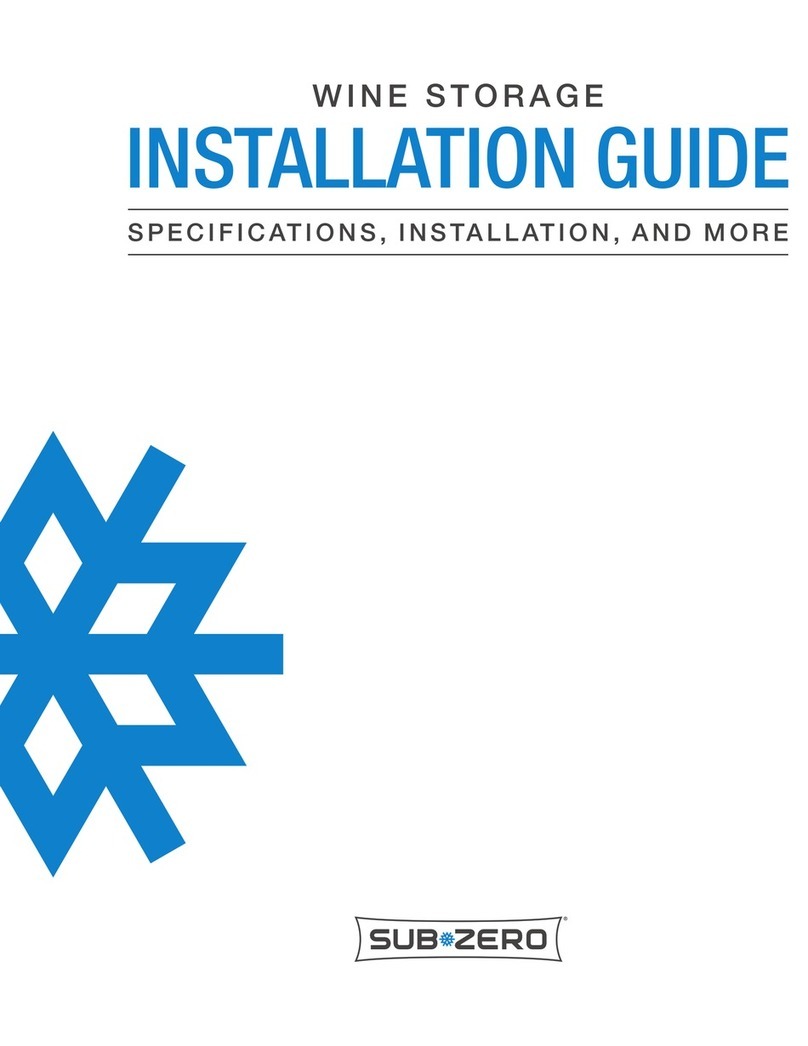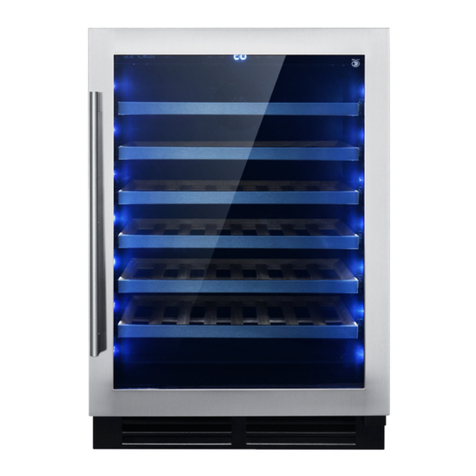Transtherm STUDIO Fitted User manual

INSTRUCTION MANUAL
Wine Cabinet
STUDIO Fitted
TT INTEGRABLE GAR final GB 1/10/01 13:56 Page 1

TRANSTHERM
121-123, rue du Maire Coppeaux - 59610 FOURMIES - FRANCE
Contents
1- Description of your wine cabinet …………………………… P 3
2- Various TRANSTHERM cabinet models …………………… P 4
3- Installing your wine cabinet ………………………………… P 5
4- Installing your wine cabinet in a fitted cupboard …………… P 5
5- Commissioning ……………………………………………… P 8
6- Settings panel ………………………………………………… P 8
7- Temperature settings ………………………………………… P 9
8- Temperature adjustments……………………………………… P 9
9- Layout and loading recommendations ………………………P 10
10- Important wine concepts………………………………………P 11
11- Everyday care of your wine cabinet …………………………P 12
12- Operating anomalies …………………………………………P 13
13- Specifications …………………………………………………P 15
TT INTEGRABLE GAR final GB 1/10/01 13:56 Page 2

English - P3
1
1
3
2
4
5
6
Cabinet body
Upper hinge
Burgundy rack
Door
Lower hinge
Bordeaux rack
Wine rack
Adjustable feet
Condensation drain hole
Hygrometer
Settings and control panel
7
9
8
10
11
Description of your wine cabinet
9
2
3
4
5
6
11
10
8
7
TT INTEGRABLE GAR final GB 1/10/01 13:56 Page 3

Various TRANSTHERM cabinet models
In order to adapt to different requirements and usages, there are 3 types of
TRANSTHERM wine cabinets. These cabinets have different characteristics
and specifications.
How do I know the model of my cabinet?
The first page of this manual has a self adhesive label on
it showing the exact model, type and serial number of
your wine cabinet.
1 temperature maturing cabinets:
MAS - MANOIR - ERMITAGE - STUDIO
Designed for storing and maturing all wines, these cabinets reproduce the exact
conditions of a natural cellar (one temperature at all times), no matter what the
outside temperature (between 0 and 35°C).
3 temperature tasting cabinets:
CASTEL - COTTAGE
In addition to the central maturing area (1 temperature) these cabinets also have
2 specific compartments for bringing to room temperature (upper compartment)
and chilling (lower compartment) a few bottles.
Multiple temperature service cabinets:
MAS - CELLIER - RÉSERVE
Also known as "Day Cellars" these cabinets are not designed for maturing but
for having all types of wine at their respective serving temperature. In fact, they
are designed in such a way that you can have 10 different temperature areas in
levels of the same cabinet (for the larger models).
important
English - P4
TT INTEGRABLE GAR final GB 1/10/01 13:56 Page 4

English - P5
important
ecommendation
important
Installing your wine cabinet
When unpacking your cabinet, make sure that there are no traces of impact or
other damage and that there are no surface defects.
Carefully remove all of the protections and adhesive strips from the packaging
around your wine cabinet.
Move your cabinet to its final location.
The place you have selected for your cabinet should:
1 - Be ventilated
2 - Enable air to pass between the wall and the back of the cabinet
3 - Be well away from any heat source
4 - Not be too damp (laundry, pantry, bathroom, etc.)
5 - Have a solid and flat floor
6 - Have a standard and accessible electricity supply (standard socket to
country standards, linked to ground).
In order for you to level off your cabinet as easily as possible, it is equipped
with 4 adjustable feet. However, we do recommend that you tighten the
back feet to the maximum and use the front feet to create a level (a spirit
level is recommended for this operation).
WAIT 48 HOURS BEFORE PLUGGING IN THE CABINET
Should you need to move your cabinet, never tilt it more than 45° and always
sideways, on the side that the electrical cable comes out.
Installing your wine cabinet in a fitted cupboard
Ensure that the cupboard base is stable, so as not to interfere with the cabinet.
Ensure correct ventilation of the cabinet by respecting the clearance shown in
the diagram on page 6. It is important that there is a space from the bottom to
the top behind the cabinet. In the event that another cabinet is to be installed
on top of the one containing the Transtherm unit, make sure that this space
continues right to the top.
1- Adjusting the feet:
- Tighten the two back feet to the
maximum as previously indicated.
Pre-setting the front feet:
- Tighten or loosen the front feet to
bring the cabinet level (see diagram).
TT INTEGRABLE GAR final GB 1/10/01 13:56 Page 5

2 - Installing the upper securing plate:
Remove the two black plastic bungs. Position and secure the plate using the
two M5X15 screws. Remove the hinge cover.
3 - Placing inside the cupboard:
Position the cabinet inside the cupboard, against the right hand side if the door
is left hand opening, or vice versa for right hand opening.
Check for stability, making sure the 2 front feet are in contact with the floor of
the cupboard, thus avoiding any warping of the cabinet body once loaded. If
this is not the case, adjust the feet until contact is achieved. The cabinet must
be located in such a way that the front is a maximum of 8mm from the front of
the cupboard (see diagram on page 7). The cabinet must then be secured using
the upper securing plate (2 cruciform head screws). Leave at least 1mm play
between the cupboard upright and its door, to ensure cabinet sealing.
4 - Securing the accompanying hinge:
Secure the accompanying hinge to the doors of the cabinet and cupboard
(see diagram page 7).
English - P6
TT INTEGRABLE GAR final GB 1/10/01 13:56 Page 6

27,5
19,5
5
150
English - P7
Securing the hinge
The line of the 2 holes must be
perfectly parallel with the
edge of the frame.
1 - Screw the hinge guide onto
the door of the wine cabinet.
2 - Open the door of the wine
cabinet to 90°, slide the rail
onto the guide and screw the
rail horizontally onto the
inside of the cupboard door.
max. 8
guide
Cupboard
door
Wine
cabinet door
36
46
30 9
TT INTEGRABLE GAR final GB 1/10/01 13:56 Page 7

Commissioning
- Once you have waited 48 hours, connect your cabinet to the mains, having
checked that there is power to the socket (check fuses and their amperage, the
state of the trip, and if necessary try out another electrical appliance to verify
the supply).
- Once connected to the mains, make sure that the Off/On switch,
on the right of your cabinet’s control panel, is set at "On" (I).
- Once connected to the mains, make sure that the Off/On switch, on the right
of your cabinet’s control panel, is set at "On" (I).
In the event of malfunction, turn to page 13
important
English - P8
Settings Panel
The temperature control(s) and setting(s) are adjusted from your wine cabinet’s
settings panel, as shown below:
Hot thermostat setting button
1 2 3 4 5 6 7
1
2Control thermostat
3Cold thermostat setting button
4Cold circuit operating indicator (green)
Hot circuit operating indicator (red)
5
6TEST button
7On/Off switch
TT INTEGRABLE GAR final GB 1/10/01 13:56 Page 8

Temperature settings
You set your wine cabinet’s temperatures from the control panel located on the
upper part of your cabinet using the hot and cold thermostat adjustment buttons
(see page 8 Nos. 1 and 3).
Standard Setting
The table below gives the standard setting enabling you to obtain the right
temperature for conserving your wines.
Model Ref
FITTED STUDIO 9 12
The settings shown in the above table are standard, given for an ambient
temperature of approximately 20°C. Depending on the outside temperature,
and/or installation conditions, and/or the load, a few adjustments may have to
be made. The setting values are not temperatures in Celsius, but are index
values.
important
English - P9
Temperature adjustment
If the load set up or the location of your cabinet calls for it, you can adjust the
temperature settings up and down.
Adjusting the temperature up
Starting off from the standard temperature settings, shift both thermostats
clockwise, keeping the same distance between them.
Adjusting the temperature down
Starting off from the standard temperature settings, shift both thermostats
anticlockwise, keeping the same distance between them.
IN ALL CASES:
AN INDEX VALUE CORRESPONDS WITH APPROXIMATELY ONE DEGREE
CELSIUS. YOU WILL NEED TO WAIT APPROXIMATELY 48 HOURS
BEFORE NOTICING THE EFFECTS OF A TEMPERATURE ADJUSTMENT.
important
TT INTEGRABLE GAR final GB 1/10/01 13:56 Page 9

English - P10
Layout and loading recommendations
Every rack can be used as a storage rack or as a sliding rack. Your cabinet’s
racks have 8 cut-outs for Bordeaux or Alsace bottle, and 7 for Burgundy or
Champagne bottles. These enable you to install your bottles in total security.
Rack layout in storage mode:
To install bottles on a storage rack, proceed as follows:
- Insert the rack in the desired position.
-Place a wooden blocking dowel in the two orifices located about 15cm from
the front of the rack, on the left and right at the top: these dowels act as a stop
against the heat formed casing and stop the rack sliding without warning (see
diagram)
-Start by arranging bottles in each cut-out in the back row, with bottle ends
towards the back.
- Continue with the front row, placing the bottles the other way around.
-Continue stacking in the same manner, taking care that no bottle touches the
back wall.
For information: the maximum capacity of a rack placed at the bottom of the
cabinet is 30 traditional Bordelais bottles.
Rack layout in sliding mode:
To arrange bottles on a sliding rack, proceed as follows:
- Insert the rack in the desired position.
-Place a wooden blocking dowel in the two orifices located about 3cm from the
back of the rack, on the left and right at the top: these dowels stop the rack from
coming right out when you pull it outwards (see diagram)
- Pull the rack towards you
-Start by arranging bottles in each cut-out in the back row, with bottle ends
towards the back.
- Continue with the front row, placing the bottles the other way around.
-A sliding rack can only take one layer of bottles.
NEVER PULL OUT MORE THAN ONE LOADED SLIDING RACK AT
A TIME
You should remember that if you do not have enough bottles to fill your wine
cabinet, it is better to distribute the load over all of the racks available, so as to
avoid "all on top" or "all below" type loads.
Don’t forget to change the dowel positions if you decide to change from slider
rack to storage rack.
important
ecommendation
TT INTEGRABLE GAR final GB 1/10/01 13:56 Page 10

Bordeaux reds 16 à 18°C
Burgundy reds 15 à 16°C
Italian reds 14 à 16°C
Spanish reds 14 à 16°C
Potuguese reds 14 à 16°C
Chilean reds 13 à 14°C
Australian reds 13 à 14°C
Washington and Oregon reds 13 à 14°C
Californian reds 12 à 14°C
Rhone reds 12 à 15°C
Roussillon reds 11 à 13°C
Languedoc wines 11 à 13°C
Burgundy whites 11 à 13°C
South African reds 11 à 12°C
German whites 10 à 11°C
Bulgarian reds 10 à 12°C
New Zealand whites 10 à 12°C
Austrian whites 8 à 10°C
Swiss reds 8 à 10°C
Hungarian whites 7 à 9°C
Sweet Bordeaux whites 6 à 8°C
Natural sweet wines 6 à 8°C
Champagne 6 à 8°C
Serving temperatures of wines (given as an indicator only)
English - P11
Important wine concepts
Your TRANSTHERM cabinet has been designed to guarantee the optimum
conditions for storing and/or serving your wine.
Wine is a highly complex product, requiring long and gentle development and
needs specific conditions in which to reach its full potential.
All wine is stored at the same temperature, only the temperatures for serving
and wine tasting can vary depending on the type of wine (see the table below).
This being the case and just like the natural cellars used by wine producers, it
is not the exact temperature that is important, but its constancy. In other words,
as long as the temperature of your cabinet is between 10 and 14° C, your wine
will be stored in perfect conditions if the temperature is not subject to any
significant fluctuation.
However, it is advisable to be especially careful concerning the values shown
on your wine cabinet's hygrometer, which, due to its location in the wine cellar
will always have tendency to display a pessimistic hygrometry level.
IRRESPECTIVE OF THE CAUSE, IF YOU NOTICE EITHER
ABNORMAL TEMPERATURE OR HYGROMETRY LEVELS INSIDE
YOUR CABINET, BE REASSURED THAT ONLY LONG EXPOSURE
TO THESE ABNORMAL CONDITIONS CAN HAVE A DETRIMENTAL
EFFECT ON YOUR WINES.
Hygrometry
You cabinet is equipped with an exclusive TRANSTHERM system enabling the
creation, inside your wine cabinet, of the correct hygrometry level required to
perfectly seal the corks in your bottles.
N
TT INTEGRABLE GAR final GB 1/10/01 13:56 Page 11

Everyday care of your wine cabinet
Your TRANSTHERM cabinet is a simple tried and tested item of equipment.
The following few operations enable you to obtain optimum operation and an
extended life cycle.
1 - Regularly remove dust (once a year) from the condenser (black metal grill
fastened to the back of your wine cabinet).
2 - Completely clean the inside of your wine cabinet once a year, taking care to
ensure that you have unplugged and unloaded it (use water and a non caustic
cleaning product, and make sure to rinse well).
The long life of your wine cabinet depends on regular monitoring,
especially of anything that may appear abnormal, and informing us of any
anomalies found.
important
English - P12
TT INTEGRABLE GAR final GB 1/10/01 13:56 Page 12

Operating anomalies
When starting up
The compressor will not operate at the temperature required, and at less
than the ambient temperature:
1 - Ensure that there is power to the electrical supply plug by connecting another
electrical appliance to it, as well as checking that the On/Off switch is in
position 1.
2 - Press on the TEST button and check that the 2 indicator lights (green and
red) light up.
3 - Turn the closed cold adjustment button in an anticlockwise direction and
check that the indicator light lights up.
4 - If after carrying out steps 2 and 3 you still cannot get the compressor to start
up correctly, contact your retailer.
The compressor will not turn off:
Adjust the cold indicator to its farthest mark and check if the cold circuit
indicator light has gone out. If the compressor will still not turn off, unplug it
and contact your retailer.
In operation
The check thermometer shows a lower temperature than required:
1 - Check the recommendation temperature adjustment (table on Page 9).
2 - Check that the red, hot circuit indicator light is lit up.
3 - Press on the TEST button and check that the 2 indicator lights (green and
red) located to the right of the panel are lit up.
If either of steps 2 and 3 are not correct, contact your retailer.
The check thermometer shows a higher temperature than required:
1 - Check the recommendation temperature adjustment (table on Page 9).
2 - Check that the green, cold circuit indicator light is lit up.
3 - Press on the TEST button and check that the 2 indicator lights (green and
red) located to the right of the panel are lit up.
If either of steps 2 and 3 are not correct, contact your retailer.
English - P13
THE USE OF GLASS DOORS HAS AN EFFECT ON PERFORMANCE
TT INTEGRABLE GAR final GB 1/10/01 13:56 Page 13

In both the aforementioned cases, if the anomaly continues following possible
recommended corrective actions and checking that the circuit indicator lights
are functioning, contact your retailer
In all cases, if your unit appears to be malfunctioning, contact your retailer.
Any intervention on the cold circuit should be performed by a refrigeration
technician, who should carry out an inspection of the circuit sealing system.
In the same way, any intervention on the electrical circuit should be performed
by an electrician.
ANY INTERVENTION PERFORMED BY A TECHNICAL SERVICE
NOT APPROVED BY TRANSTHERM WILL LEAD TO THE
GUARANTEE BEING CONSIDERED AS NULL AND VOID
important
important
ecommendation
English - P14
TT INTEGRABLE GAR final GB 1/10/01 13:56 Page 14

Specifications
FITTED
FITTED
Electrical
power Consumption
per 24hrs Voltage* Hz Frequency
*Usage restrictions
T°min T°max
128W 0,68Kwh/24h 230 50 0°C 35°C
* These values may vary according to the country. To see the specific characteristics of your
appliance, please consult the self adhesive label on the front of this manual.
Temperatures Height Width Depth Tolerance
Reference Weight
1640mm 540mm 557mm 35 kg +/- 2°C
Model
STUDIO
Model Refrigerant
gaz
R 134a
English - P15
TT INTEGRABLE GAR final GB 1/10/01 13:56 Page 15

Warning
The information contained in this document may be subject to modification
without prior notice.
TRANSTHERM offers no guarantee on this item if it is subjected to use other
than that for which it is designed. TRANSTHERM cannot be held responsible
for any errors in this manual, nor for any damage linked to or following the
provision, performance or use of this item.
This document contains original data, protected by copyright. All rights are
reserved. Photocopying, reproduction or translation of this document, whether
total or partial, is strictly prohibited without prior written consent from
TRANSTHERM.
English - P16
TT INTEGRABLE GAR final GB 1/10/01 13:56 Page 16

English - P17
Notes
TT INTEGRABLE GAR final GB 1/10/01 13:56 Page 17

05/2001
TT INTEGRABLE GAR final GB 1/10/01 13:56 Page 18
Table of contents
Other Transtherm Wine Cooler manuals
Popular Wine Cooler manuals by other brands

Avintage
Avintage AVI47XDZA use instructions
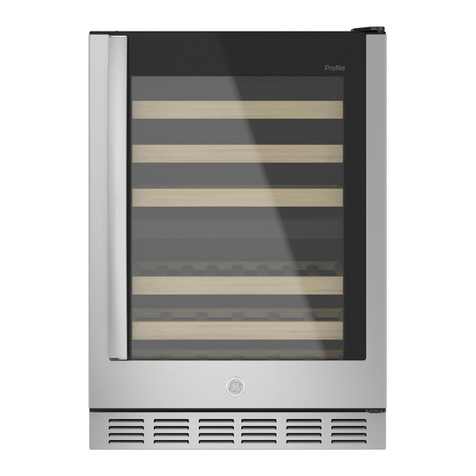
GE
GE PWS06D Series Owner's Manual & Installation Instructions

Howard Miller
Howard Miller 695015 instructions
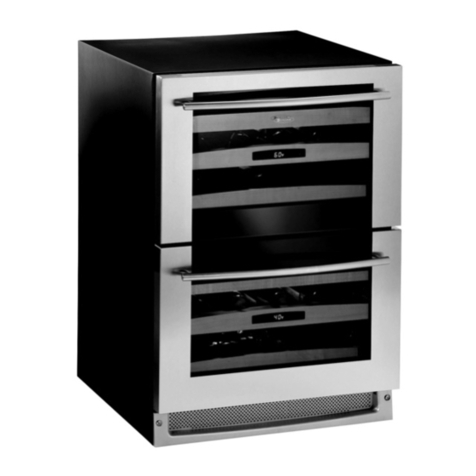
U-Line
U-Line Echelon 2275DWRWS Specifications
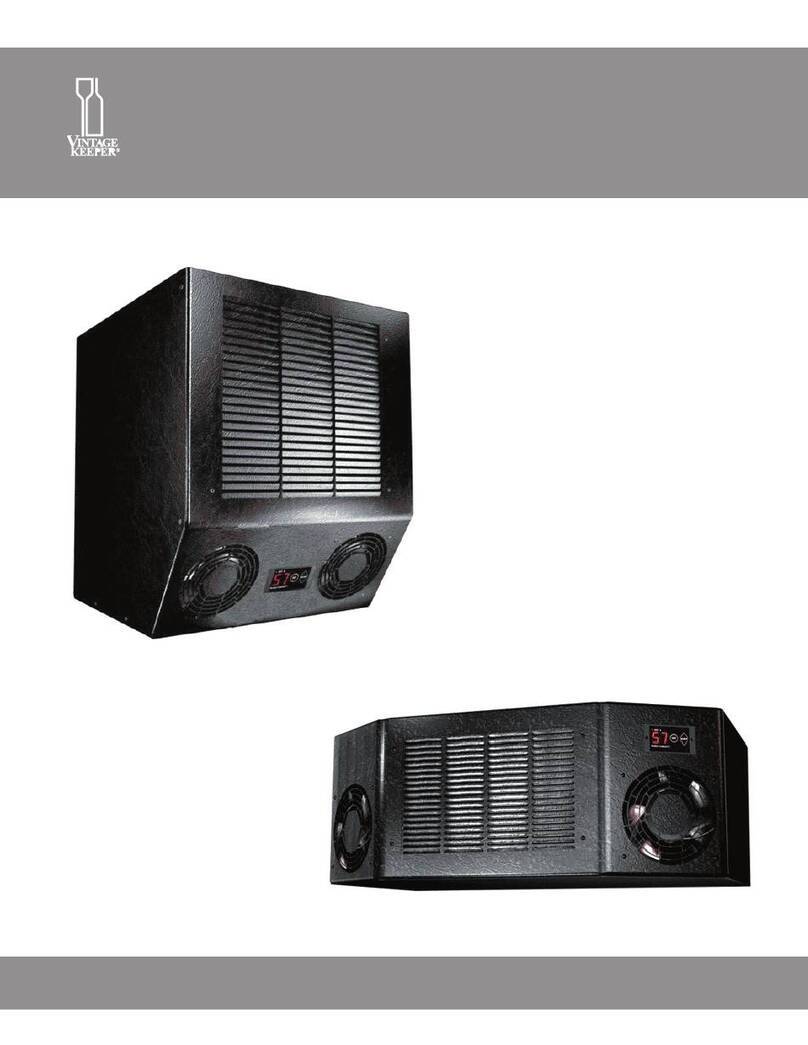
Vintage Keeper
Vintage Keeper INTERKOOL 300 Installation & operation manual

Midea
Midea UR-JC49G-DQ Service manual
